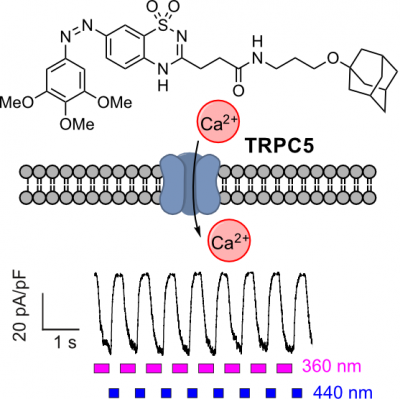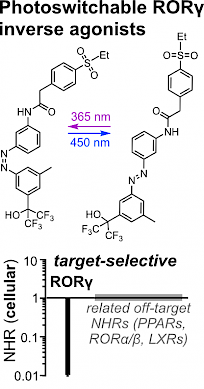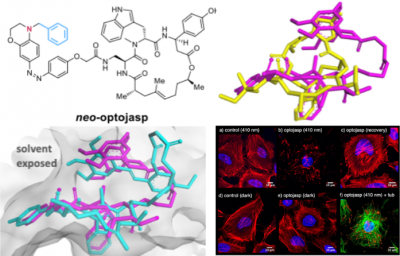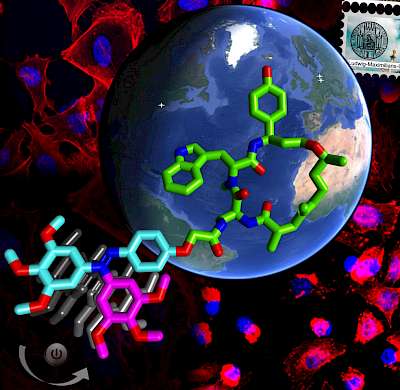Protein Photocontrol: Beyond Microtubules
Conceptual: Photoswitches can be reversibly photoisomerised with excellent spatiotemporal precision. This generally recommends reagents that incorporate photoswitches (photopharmaceuticals) as tools for studying the biology of inherantly anisotropically active protein targets, or proteins with rapid temporal responses e.g. signal integration and cascade transmission systems.
(a) Creating photopharmaceutical tools with sufficient biochemical specificity and potency is a clear challenge that we and many others are engaged in, and this must be addressed in a target-by-target fashion based on ligand binding sites.
(b) More unusually, we give equal priority to tool robustness, which for us includes the ease of transfer between model systems, from cell culture to in vivo. Repeatability of compound action and reagent solubility are clear criteria here; but our recent conceptual analysis is now promoting a general re-write of how to even design photoswitchable tools in the first place (BioRxiv 2024) in order to avoid them "failing late" upon in vivo introduction. We are suggesting to design for what we term ideal efficacy switches, in order to deliver protein chromocontrol, rather than the ubiquitous current design paradigm of affinity switches created through e.g. azologisation, that deliver conflated photocontrol.
End-User / Target-based: We work on several target spaces beyond microtubules, that bring new pharmacological challenges and biological opportunities:
(A) TRP channels form a family of 28 ion channels, playing prime roles in sensory integration of simultaneous signal inputs (temperature, pH, chemical ligands, etc) as well in the bulk mineral transport (homeostasis) needed for cell survival and replication. Kickstarted by the DFG Transregio SFB152 TRiPs to Homeostasis we are working on new photopharmaceutical modulators of TRP channels, for high-temporal-precision studies of their functional roles in vitro and in vivo. As high-impact sensory and signaling systems that can be exquisitely primed for chemical intervention, TRPs offer photopharmacologist fertile grounds for methodological explorations far beyond the current paradigms of "switching a blocker more-on and more-off". For an excellent introduction to sensory receptor modulation, see Colquhoun 1998.
 |
 |
 |
| Chromocontrol, Ideal Efficacy Switching, TRPC4/5 & in vivo: rewriting how to build in vivo photoswitches (BioRxiv 2024) | BTDAzo: the first Trpc5-selective photoswitchable modulator, applied from cell culture to tissue slice (Angewandte 2022) | 26E01: a novel, selective, nontoxic blocker for TRPV3 (Cell Calcium 2020) |
(B) Target-based Collaborations: we collaborate to develop photoresponsive bioactive tool compounds for various cellular target systems as opportunities arise.
 |
 |
 |
| MRORs: the first photoswitchable modulators of nuclear hormone receptor RORγ (Angewandte 2024; with the Merk group) |
neo-optojasps: self-switch-off (fast-relaxing) photoswitchable actin cytoskeleton inhibitors (Angewandte 2022; with the Trauner and Arndt groups) |
optojasps: first-in-class photoswitchable actin cytoskeleton inhibitors (JACS 2020; with the Arndt and Trauner groups) |


